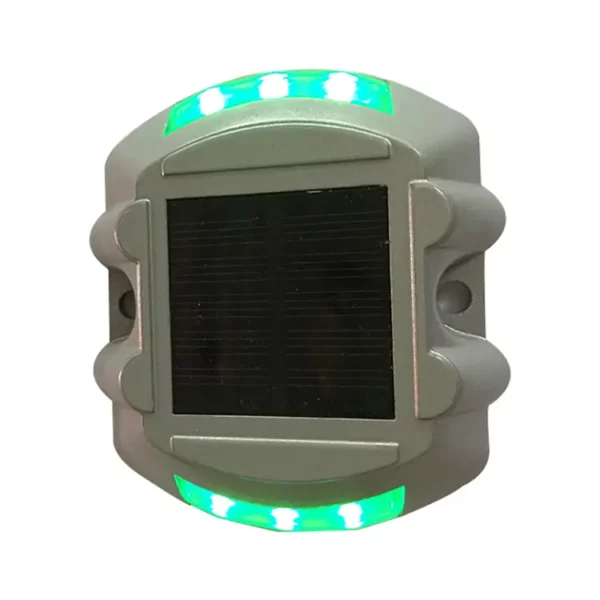Maintenance requirements for road studs may vary depending on the specific type and design of the studs, as well as the environmental conditions in which they are installed. However, here are some general maintenance guidelines and information on their durability:
Maintenance Requirements:
- Regular Cleaning: Road studs should be cleaned periodically to ensure they remain visible. Dust, dirt, and debris can accumulate on the stud’s surface, reducing their reflective properties. Cleaning can often be done using standard road maintenance equipment.
- Reflective Surface Inspection: Road studs typically have reflective elements, such as retroreflective lenses or materials. Inspect these reflective surfaces for wear, fading, or damage. Replace or repair any compromised reflective components to maintain visibility.
- Tightening and Fastening: Regularly check the fasteners and connections that secure road studs to the road surface. Ensure that they are tight and in good condition. Loose studs can be hazardous and may need to be reinstalled securely.
- Battery Maintenance (if applicable): Some road studs, especially those with integrated LED lights, may have batteries that require maintenance or replacement over time. Periodic inspection and battery replacement may be necessary.
- Sealing and Waterproofing: Proper sealing and waterproofing are essential to prevent water and moisture from entering the internal components of the road studs. Seals and gaskets should be inspected and replaced as needed to maintain the integrity of the unit.
- Electronics Inspection (if applicable): If the road studs have integrated electronics, such as LED lights, regularly inspect these components for signs of wear, damage, or malfunction. Replace or repair any compromised electronics.
Durability:
The durability of road studs can vary depending on factors such as the quality of the product, the materials used, and the environmental conditions in which they are installed. Here are some considerations:
- Quality of Materials: Road studs made with high-quality materials, such as corrosion-resistant metals and durable plastics, tend to be more durable.
- Environmental Conditions: Road studs in harsh environments with extreme weather conditions (e.g., heavy rain, snow, and extreme temperatures) may wear out more quickly.
- Traffic Load: The amount and type of traffic passing over the road studs can impact their durability. High-traffic areas may require more frequent maintenance.
- UV Resistance: Road studs should be UV-resistant to withstand prolonged exposure to sunlight without fading or degrading.
- Impact Resistance: Road studs are designed to withstand the impact of vehicle tires and heavy traffic without becoming damaged or dislodged.
In summary, proper maintenance is essential for ensuring the long-term durability and functionality of road studs. High-quality road studs, when well-maintained, can provide several years of reliable service in enhancing road safety and visibility.
How do road studs play a role in traffic management and guidance on highways and urban roads?
Road studs play a crucial role in traffic management and guidance on highways and urban roads by providing visual cues, enhancing road safety, and aiding in navigation. Here’s how road studs contribute to these functions:
- Lane Marking and Division: Road studs are used to mark lanes and divide traffic on highways and urban roads. They help drivers stay within their lanes, reducing the risk of lane departure accidents and promoting orderly traffic flow.
- Lane Change and Merging: Special road studs, such as those with chevron patterns or arrows, are used to guide drivers during lane changes and merging. They indicate where vehicles should move to enter or exit lanes safely.
- Edge Marking: Road studs are often placed along the edges of roadways, indicating the boundaries of the road. These studs help prevent vehicles from inadvertently drifting off the road and onto shoulders or into ditches.
- Pedestrian Crossings: In urban areas, road studs with specific patterns or colors may be used to highlight pedestrian crossings. China road stud suppliers These studs enhance pedestrian safety by making crosswalks more visible to drivers.
- Roundabouts and Traffic Circles: Road studs are used to outline the lanes within roundabouts and traffic circles, guiding vehicles through these intersections safely and efficiently.
- Centerline Markings: On highways, road studs may be used to mark centerlines, helping drivers maintain proper lane discipline and prevent head-on collisions.
- Turn and Exit Lanes: Road studs can guide drivers to exit ramps, turn lanes, and other specific routes. They provide clear directions for vehicles entering and exiting the highway or urban roads.
- Speed Control: Road studs may be used in conjunction with other road signage to indicate speed limits or advisory speed changes. They help drivers adjust their speed as needed for safety.
- Hazard Warnings: Some road studs are equipped with flashing or reflective elements to draw attention to specific hazards, such as curves, intersections, or construction zones. These studs serve as visual warnings to alert drivers.
- Navigation Aid: Road studs can be used as navigation markers, particularly in rural or less well-lit areas. They provide a continuous, visible path for drivers to follow when other cues may be limited.
- Visibility in Low-Light Conditions: Road studs are equipped with reflective materials and sometimes integrated LED lights, making them highly visible, especially at night or in adverse weather conditions. This enhances visibility and safety for drivers.
- Snow and Ice Control: In regions with snowy or icy conditions, road studs can help plow operators identify lane divisions and keep roads clear during winter maintenance.
Overall, road studs are integral to effective traffic management and guidance on highways and urban roads. They assist drivers in maintaining lane discipline, navigating intersections, responding to hazards, and ensuring safe and efficient traffic flow. Their visibility, particularly in low-light conditions, makes them a valuable component of road safety and infrastructure.
